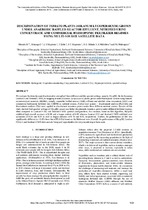| dc.contributor.author | Sibanda, M | |
| dc.contributor.author | Mutanga, O | |
| dc.contributor.author | Dube, T | |
| dc.date.accessioned | 2021-06-22T07:16:32Z | |
| dc.date.available | 2021-06-22T07:16:32Z | |
| dc.date.issued | 2019 | |
| dc.identifier.citation | Sibanda, M. et al. (2019). Discrimination of tomato plants (solanum lycopersicum) grown under anaerobic baffled reactor effluent, nitrified urine concentrate and commercial hydroponic fertilizer regimes using multi-source satellite. International Archives of the Photogrammetry, Remote Sensing and Spatial Information Sciences - ISPRS Archives, 42(4/W18), 1023–1029. https://doi.org/10.5194/isprs-archives-XLII-4-W18-1023-2019 | en_US |
| dc.identifier.issn | 2194-9050 | |
| dc.identifier.uri | https://doi.org/10.5194/isprs-archives-XLII-4-W18-1023-2019 | |
| dc.identifier.uri | http://hdl.handle.net/10566/6320 | |
| dc.description.abstract | We evaluate the detection and discriminative strength of three different satellite spectral settings, namely, HyspIRI, the forthcoming
Landsat 9 and Sentinel 2-MSI, in mapping tomato (Solanum lycopersicum) plants grown under hydroponic system using humanexcreta
derived materials (HEDM), namely, anaerobic baffled reactor (ABR) effluent and nitrified urine concentrate (NUC) and
commercial hydroponic fertilizer mix (CHFM) as nutrient sources. Partial least squares – discriminant analysis (PLS-DA) and
discriminant analysis (DA) were applied to discriminate tomatoes grown under these different nutrient sources. Results of this
study showed that spectral settings of HyspIRI sensor can better discriminate tomatoes grown under different fertilizer regimes
when compared to Landsat 9 OLI and Sentinel-2 MSI spectral configurations. For instance, based on DA algorithm, HyspIRI
exhibited high overall accuracy of 0.99 and a kappa statistic of 0.99 whereas Landsat OLI and Sentinel-2 MSI exhibited over
accuracies of 0.94 and 0.95 as well as kappa statistics of 0.79 and 0.85, respectively. Further, the performance of DA was
significantly different (α = 0.05) from that of PLS-DA based on the MaNemar tests. Overall, the performance of HyspIRI, Landsat
9 OLI-2 and Sentinel-2 MSI data seem to bring new opportunities for crop monitoring at farm scale. | en_US |
| dc.language.iso | en | en_US |
| dc.publisher | ISPRS | en_US |
| dc.subject | Hydroponic | en_US |
| dc.subject | Vegetation monitoring | en_US |
| dc.subject | Crop production | en_US |
| dc.subject | Landsat 9 OLI | en_US |
| dc.subject | Hyperspectral data | en_US |
| dc.title | Discrimination of tomato plants (solanum lycopersicum) grown under anaerobic baffled reactor effluent, nitrified urine concentrate and commercial hydroponic fertilizer regimes using multi-source satellite data | en_US |
| dc.type | Article | en_US |

